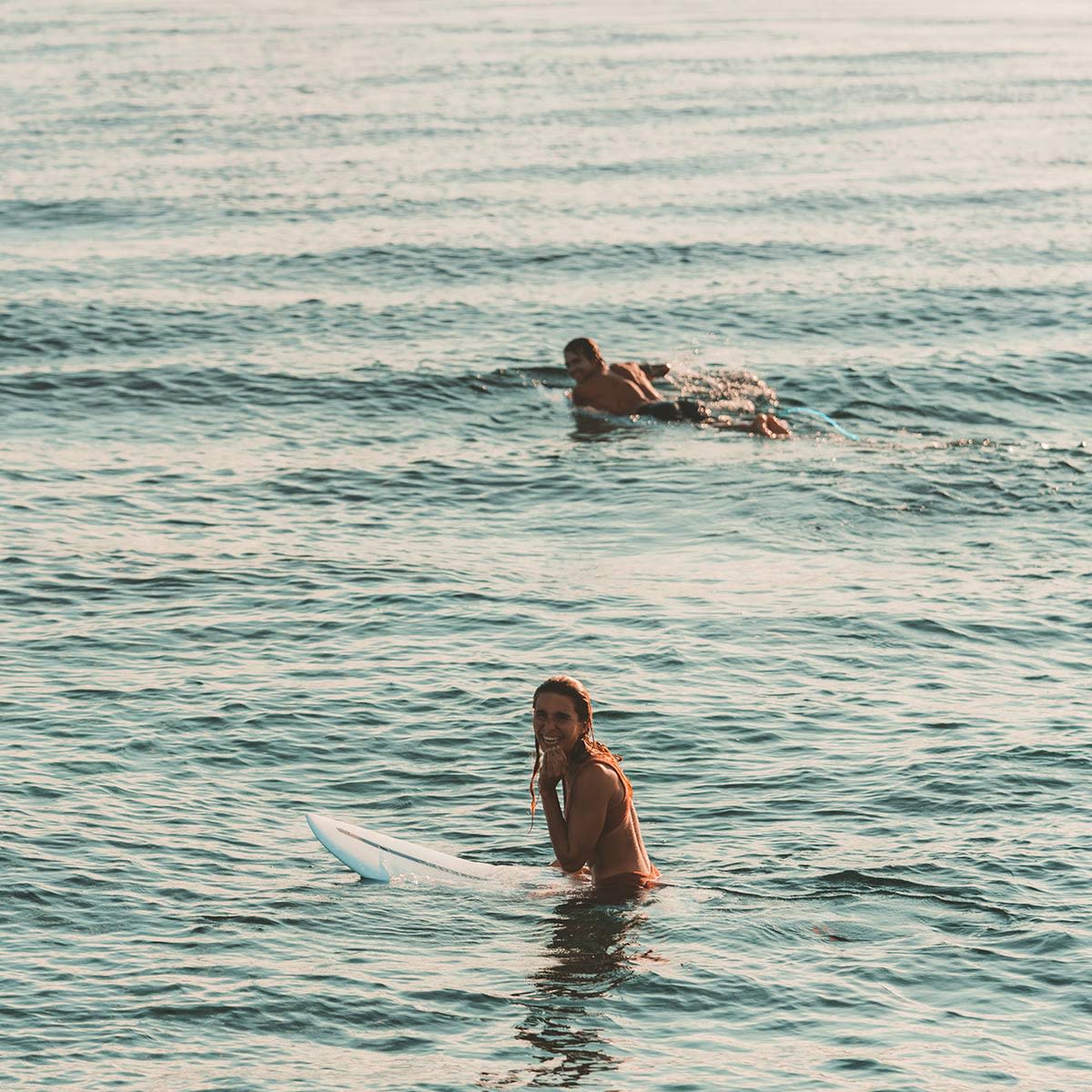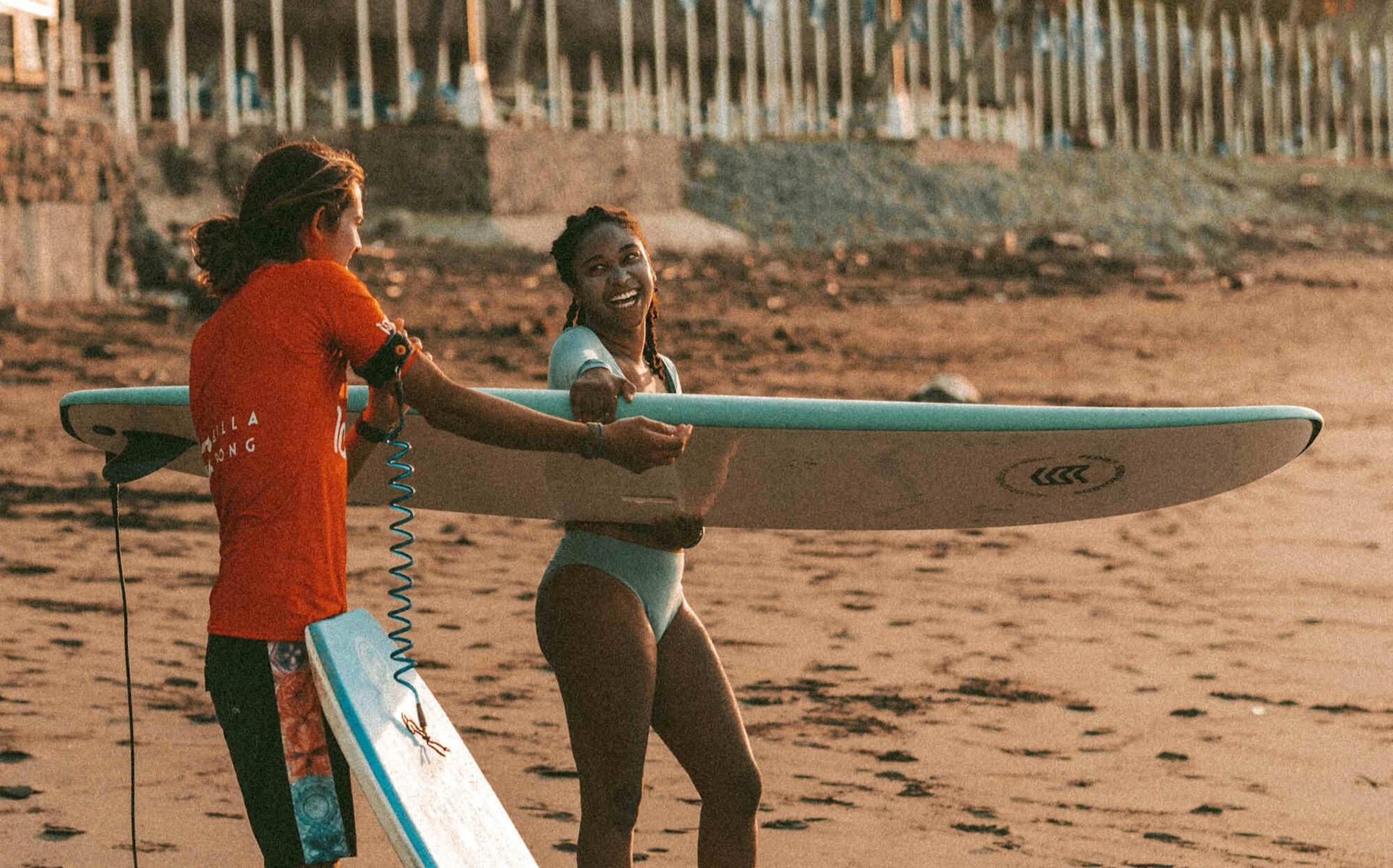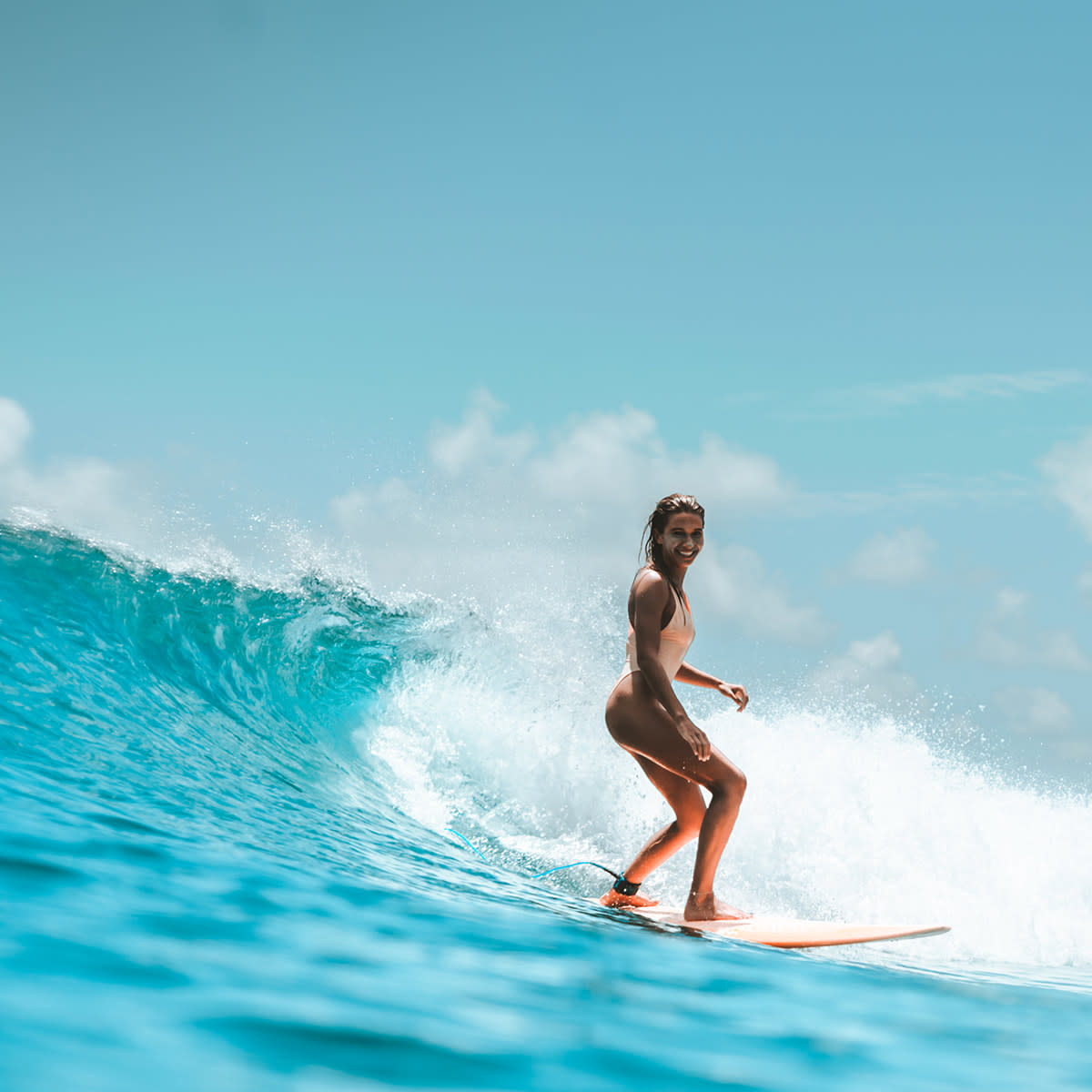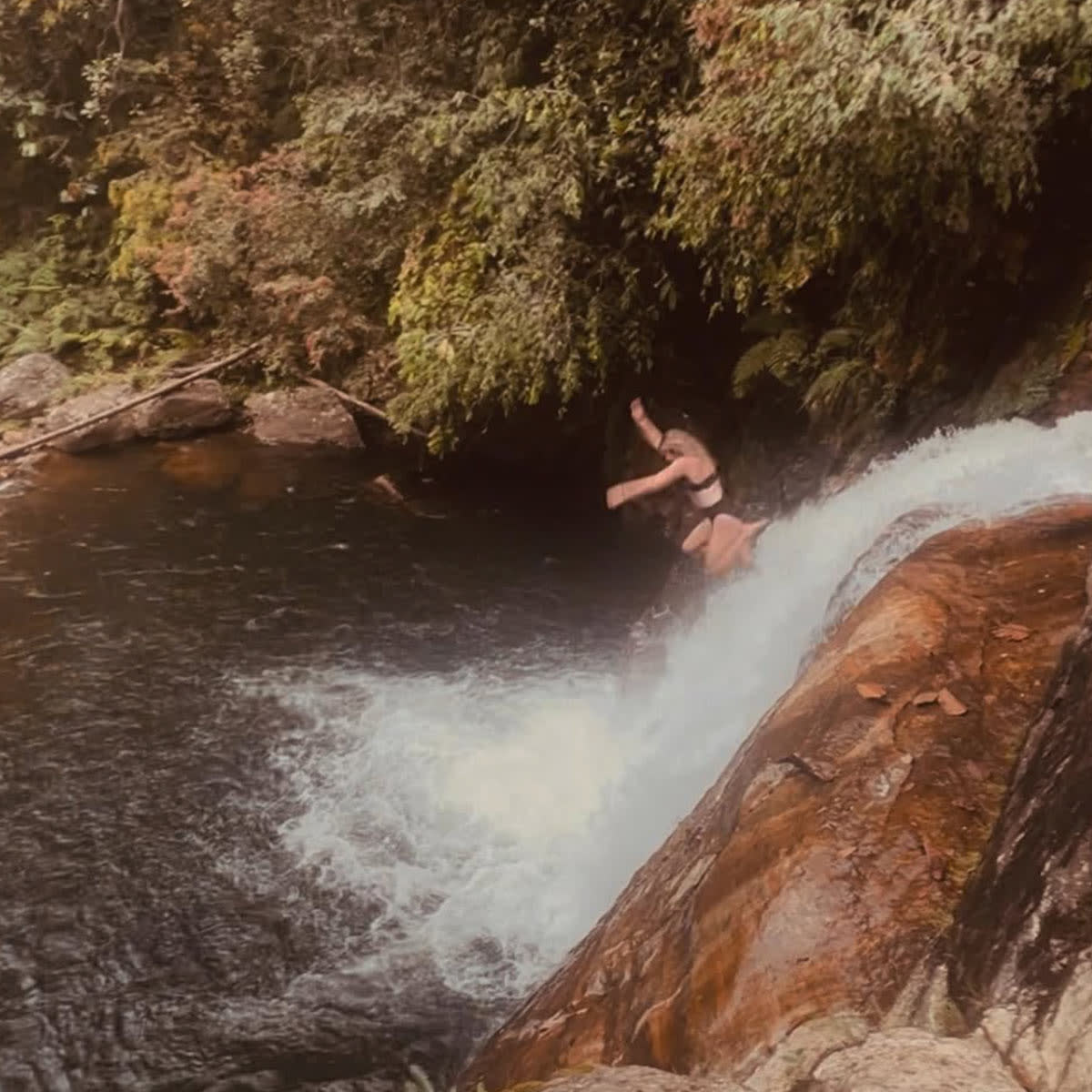
The best sunscreen for surfing: Reef-safe & ocean-friendly sun protection
August 6, 2025Looking for the best sunscreen for surfers? In this guide, we break down everything you need to know about reef-friendly sunscreen that actually stays on while you surf. From ingredients to avoid to long-lasting formulas that love the ocean as much as you do, this is your ultimate sun protection surf guide.
Surfers put sunscreen to the ultimate test with long hours in the water, constant sun exposure, and the salty splash of the ocean. But choosing the right one isn’t just about avoiding a lobster face. It’s about protecting your skin and the places we love to surf.
An estimated 4,000 to 6,000 tons of sunscreen wash into the ocean every year. Chemical ingredients in many mainstream sunscreens have been shown to harm coral reefs and marine life, leading to global bans and a rise in awareness around reef-safe and ocean-friendly alternatives. But what does “reef-safe” even mean? And how do you find a sunscreen that won’t slide off your face mid-paddle?
We’ll take you through what to look for (and what to avoid), share our top picks for surf-proof sunscreen, and answer your most asked questions.
Things you should look for in a surf-friendly sunscreen:
No harmful chemicals (avoid oxybenzone, octinoxate, and octocrylene)
Reef-safe/mineral-based ingredients
Non-nano particles
Water resistance
Broad-spectrum protection (UVA + UVB)
Thick, long-lasting coverage
Does this list make you feel like “I should look for WHAT now?”. Then don’t worry, we’re here to make you a sunscreen expert in no time! At the end of the post, you’ll find a sunscreen checklist that will make it much easier to understand.
The two main types of sunscreen
The sunscreen world is a bit of a jungle, so let’s start with understanding that there are two main types of sunscreen:

1. Chemical sunscreens
How they work: They absorb UV rays like a sponge, then convert them into heat and release them from the skin.
Ingredients to watch out for: Oxybenzone, octinoxate, octocrylene, homosalate, avobenzone, etc.
Why they're not reef-friendly: Some of these ingredients have been shown to harm coral reefs and marine life, even in tiny amounts.
2. Physical (mineral) sunscreens
How they work: They sit on your skin and physically block UV rays, like tiny mirrors reflecting sunlight.
Main ingredients: Zinc oxide and titanium dioxide.
Why they’re considered reef-safe: They don’t seem to harm coral reefs when used in non-nano form (we’re getting back to that later on).
So, while all chemical sunscreens aren’t the bad guys, if you’re surfing or swimming in sensitive marine areas, reef-safe physical (mineral) sunscreens with zinc oxide or titanium dioxide are usually the safer, more eco-friendly choice.
What does reef-safe mean?
"Reef-safe" means the sunscreen doesn’t contain ingredients that are toxic to coral reefs and marine life. The biggest red flags to avoid are oxybenzone, octinoxate, octocrylene, and homosalate (we’ll get into why in a bit), which can disrupt coral reproduction, damage DNA, and contribute to bleaching.
And to make it even harder: Some sunscreens market themselves as “reef-safe” even if they still contain questionable ingredients. The term isn’t regulated, so just saying "reef-safe" on the bottle doesn't mean it's legit.
Which ingredients should you look out for?

A 2025 study called 'Effects of three sunscreens on the ecophysiology of hard and soft corals from the Maldives' looked at how common sunscreen ingredients affect coral reefs. It found that chemicals like oxybenzone, octinoxate, and octocrylene can build up in coral and seawater and cause serious damage, even at low levels. These chemicals can make corals bleach (AKA turn white and sick), mess with the tiny algae they need to survive, and harm the coral’s natural bacteria.
Avoid these harmful chemicals:
Oxybenzone
Octinoxate
Octocrylene
Homosalate
Avobenzone (debatable)
Parabens
Synthetic fragrances
These can be harmful to both your skin and the environment. Let’s dive a little deeper:
Oxybenzone = Very bad
One of the most damaging sunscreen chemicals out there. It causes coral bleaching, DNA damage, hormone disruption in fish, and even death in coral larvae. In other words, it’s a big no!
Octinoxate = Also bad
Linked to coral bleaching and can harm fish development. Banned in places like Hawaii for this reason.
Octocrylene = Problematic
This chemical builds up in fish and other sea creatures over time. It can also turn into another substance called benzophenone, which might be toxic. Scientists are starting to worry more about it, and new studies are looking into how bad it really is.
Homosalate = Potentially harmful
Not as well studied in marine environments, but it builds up in the body and may harm marine life. Often grouped with other “watch list” chemicals.
Avobenzone = Debatable
Not directly linked to coral bleaching, but can become unstable in sunlight and may react with chlorine or metals to form harmful byproducts. Often combined with other problematic ingredients.
Parabens = Not ocean-friendly
Preservatives that can disrupt hormones in marine species and are toxic to coral at high levels.
Synthetic fragrances = Generally bad
Many contain phthalates or aldehydes, which are toxic to marine organisms and do not break down easily in the environment. Look for “Fragrance-free” or “no synthetic fragrance” instead.
Choose Physical sunscreen/mineral-based ingredients

Using physical sun protection is the way to go to stay reef-friendly, preferably those that contain only zinc oxide or titanium dioxide.
Non-nano zinc oxide: A natural mineral that sits on the skin’s surface to physically block UV rays without being absorbed, making it safe for you and the ocean.
Non-nano titanium dioxide: Another mineral that reflects UV rays from the skin’s surface, with larger particles that don’t penetrate skin or harm marine life.
What does non-nano mean?
It means the tiny particles in a product are bigger than 100 nanometers (which is one billionth of a meter), small enough to work well, but big enough not to be absorbed into your skin or the environment! This makes them safer for both you and nature compared to nano-sized particles, which are much smaller and can penetrate more easily.
What does SPF 15, SPF 30 & SPF 50 really stand for?
SPF stands for Sun Protection Factor; it tells you how much longer you can stay in the sun without getting sunburned compared to no sunscreen.
SPF 15 means you can stay out 15 times longer before burning.
SPF 30 means you can stay out 30 times longer before burning.
SPF 50 means you can stay out 50 times longer before burning.
So let’s do some quick math: if your skin normally starts to burn after 10 minutes without protection, with SPF 15, you could theoretically stay out for about 150 minutes (15 x 10) before burning, but it’s always safer to reapply often!
But remember, no sunscreen blocks 100% of UV rays (SPF 30 blocks ~97% of UVB, SPF 50 blocks ~98%), so it’s important to reapply regularly, especially when surfing or sweating!
How often should you reapply sunscreen?

You should reapply sunscreen every 2 hours at a minimum, even more often if you’re swimming, sweating, or wiping your face.
For surfing or any water sport, reapply right after you get out of the water because water can wash it off, even if it says “water-resistant.” And don’t forget to put sunscreen on all exposed skin, including ears, neck, and the back of your hands!
What's UVA and UVB?
UVA and UVB are two types of ultraviolet (UV) rays from the sun that can harm your skin:
UVA rays: go deeper into your skin and cause aging, wrinkles, and long-term damage.
UVB rays: mainly affect the surface of your skin and cause sunburn.
Good sunscreen protects against both UVA and UVB, which is called broad-spectrum protection, so you stay safe from sunburn and skin damage!
What does water-resistant mean?

Water-resistant sunscreen means the sunscreen is designed to keep protecting your skin even when you’re sweating or swimming. It won’t just wash off right away when you hit the water.
The number, like 80 minutes, tells you how long the sunscreen is supposed to keep working while you’re in the water or sweating before you need to reapply.
If the sunscreen doesn’t say anything about water resistance, it’s probably best to assume it will wash off pretty quickly.
When's the best time to apply sunscreen before surfing?
Apply your mineral sunscreen 15–30 minutes before surfing so it can fully set on your skin. This helps it form a strong, protective barrier that won’t wash off easily. Make sure to cover all exposed spots and let it dry before paddling out.
Is zinc better than regular sunscreen for surfing?
Yes, for most surfers, non-nano zinc oxide is the gold standard. It creates a physical barrier that lasts longer in the water and offers reliable, broad-spectrum protection without harming marine ecosystems. It’s also less likely to cause breakouts or irritation.
What should you look for in the best zinc?

When it comes to the best zinc for surfing, you want something that’s:
Reef-safe (non-nano zinc oxide)
Water-resistant (ideally 80 minutes or more)
Thick and visible (so you know it’s still on)
Long-lasting, even in heavy surf
Safe for your skin, especially for sensitive or acne-prone faces
What is the best sunscreen for surfing?

Some of the top-rated reef-safe sunscreens for surfing and watersports include:
Raw Elements: Broad-spectrum zinc formula, water-resistant, no white residue if rubbed in.
SunBum Mineral SPF 50: Reef-safe, non-nano zinc, great for sensitive skin.
Manda Organic Sun Paste: Made with thanaka, long-lasting and ideal for tropical surf trips.
Zinka Colored Nosecoat: Fun and functional, thick zinc in colors, a classic surf staple.
SurfDurt: Made by surfers, for surfers, all-natural, reef-safe, and smells great.
Table: The best surf sunscreen and zinc for surfers
Here's a summary of the best sunscreens for surfing, including face, zinc, lip balm, and aftersun options:

How to apply sunscreen for surfing: Step-by-step
Choose the right sunscreen, as we talked about in this guide.
Apply the sunscreen 15-30 minutes before surfing: Give your sunscreen enough time to fully absorb or set on your skin. Applying it well before you paddle out helps create a strong, water-resistant barrier.
Use enough sunscreen: Don’t skimp! Use about a shot-glass amount (1 to 2 teaspoons) to cover your face, neck, ears, and any exposed skin. Thick layers can provide better protection and are less likely to wash off immediately.
Rub it in well, but leave a visible layer: Mineral sunscreens (zinc-based) can be thick and visible, and that’s good! It means you’ve applied enough. Rub it in so it’s not clumpy but still noticeable.
Focus on high-exposure areas: Make sure to cover your:
Face (especially nose, cheeks, forehead)
Neck and back of the neck
Ears (often forgotten but very sensitive)
Lips (use an SPF lip balm)
Shoulders and arms if they’re exposed
Reapply often: Even if your sunscreen says “water-resistant,” reapply every 2 hours or immediately after getting out of the water. Saltwater and wiping your face can reduce protection.
Don’t forget your lips: Use a reef-safe SPF lip balm to protect your lips from sun damage and wind.
The perfect sunscreen checklist

You’ve got to check the ingredient list yourself. Look for:
✅ Zinc oxide or titanium dioxide sunscreen (non-nano only!)
❌ Avoid: Oxybenzone, octinoxate, octocrylene, homosalate, and parabens
✅ “Fragrance-free” or “no synthetic fragrance”
✅ Broad-spectrum protection: Blocks both UVA (aging) and UVB (burning) rays
✅ SPF 30 or higher
✅ Water-resistant (80 minutes or more)
✅ Reapply every 2 hours, and after swimming
We now dub you a sunscreen expert. Stay safe, stay reef-friendly, and happy surfing!
Note: Science is always evolving, especially around sunscreens and ocean health. This guide is based on the latest research, but things can change. So keep it smart, stay updated, and choose sunscreen that’s good for you and the ocean.
Newsletter
Stay up to date!

Beatrice Lindfors
About the author: My name is Beatrice, but Bea for short, and I’ve been a writer and content creator for Lapoint since 2022. My life revolves around my laptop and backpack as I travel the world, always with a stop in Ericeira; the camp vibe and the Portuguese sunsets have my heart.
Life goal? Visit every country.
Obsession? The Sri Lanka waves, the Atlantic Ocean and tracking down the best coffee (whichever my current location is).

